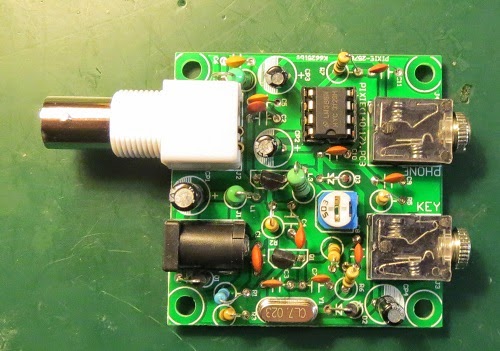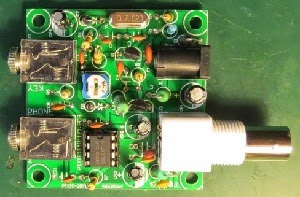Author Archive
 40m Pixie – bench test went well
40m Pixie – bench test went well
Well, it took a super-human effort on my part as a result of my extreme fatigue (brain bleed issue) but today I bench tested the little 40m Pixie kit I managed to build earlier this week. It is hard to explain just how exhausting this simple task was for me currently. I now need to recover my energy!
On receive a 1uV signal was perfectly readable and I could detect carrier on/off down to at least below 0.5uV. On TX it was putting out about 250mW into a 50 ohm load. On my antenna it was suffering some AM breakthrough, but less than I was expecting. I was using standard Walkman stereo headphones and a rechargeable 12V sealed lead acid battery. On a small 9V battery I’d expect about 100mW RF out, although this was not tried.
Overall, these results exceeded my expectations: it is more sensitive than I was expecting and the breakthrough of AM broadcasters is certainly OK in the day time. This is of course with no casing at all and no ATU. Using the fitted pot and fitted 1N4001 as a varicap it is easy to get the TX frequency and RX frequency to correspond, often an issue with very simple QRP rigs.
Next stage will be some on-air tests, but it most definitely works. Working the locals should certainly be possible. Sked with G6ALB (3km) arranged for 1000z Sunday on 7.023MHz CW.
UPDATE 2120z: There is a contest in full swing and several Russians and Asiatic Russians copied on the little 40m Pixie. I did not stay on long but there was no apparent BC interference noticeable. So, on a quiet night I should able to use the rig in the evenings. The main issue on RX seems to be the lack of AF filtering, so one has to use “the filter that is between the ears” i.e.the brain.
 Frog 40m transceiver
Frog 40m transceiver
This is the Pixie’s “big brother”. I have mentioned it before in this blog. It has more power than the Pixie and a better RX. Best of all it costs just over £15 built with free shipping from Hong Kong.
 40m Pixie
40m Pixie
Yesterday I found my rechargeable 12V battery and charged it up. I also checked the Pixie I built as a kit for dry joints and shorts. As all looks good, I hope to test this on the air over the weekend or early next week.
There are a couple of locals I’d like to test with initially, although I am expecting to suffer from AM breakthrough mainly from broadcast stations very close to our 40m band. Probably there would be less breakthrough in the daytime? My antenna is short and low on 40m (a Par triband end-fed covering 10m/20m/40m) so any contacts will be good!
I can test it first on a signal generator and then a power meter. If it works, I’d expect a sensitivity of around -100dBm and a power out of around 200mW on 40m. We’ll see. Even -80dBm and 100mW would be enough to work locals as long as AM breakthrough is at a manageable level.
 10m SSB with the Lincoln Mk2
10m SSB with the Lincoln Mk2
This afternoon, I have been trying out the President Lincoln Mk2 (V3) which arrived early today. I have only tried on SSB but it seems to work, with the first SSB QSO being with N8II in West Virginia at about 1430z. He was using 800W and a 5 element beam! It was hearing plenty from Asia, Europe and North/South America. Maximum claimed power from the Lincoln, controlled by a rotary control on the front panel, is 31W PEP on SSB.
 |
| Lincoln Mk2 with the other rigs |
I have still to fully get to grips with the menu but it seems pretty intuitive. There is a choice of display backlight colours, but I find green easiest on the eyes. The other choices are blue and orange. You can alter display brightness and lots of other features – I shall have plenty of time to play. Blue is not good for my eyes on either the Lincoln Mk2 or the FT817. To my eyes, blue is hard to see, whereas the green is very clear.
My biggest issue was getting the power leads attached to the PSU. Before my stroke this would have been trivial. Now it tires me out! I wanted several rigs attached to the PSU at the same time so soldering the plugs on was non-trivial. As you know, speaking too long exhausts me,so I am taking a break.
I am waiting for my 12V battery to charge to test the 40m Pixie. Visually the Pixie build looks fine.
At the moment I am not on WSPR on any band.
 Invisible disabilities
Invisible disabilities
I have come to the conclusion that it is better to be disabled in a visible way than have a disability that cannot be seen easily. On a walk this afternoon at Anglesey Abbey there were quite a few people who were clearly disabled.
My wife says when I walk you cannot tell I have a disability. Inside, I still feel like I am drunk, I tire easily and I still feel wobbly when walking. My voice is still poor and swallow of thin liquids is poor.
Most people think I am fine now. I am still a long way from that although I still feel I am making slow improvements. My current disability is invisible to many.
The ongoing after-effects of my cerebellum brain bleed are the reason I try to avoid too much speaking on the air. WSPR is my favourite mode as no talking is needed. JT65 and JT9-1 are my favourite 2-way digital modes. Although I have used PSK31 I don’t much like it as too many use macros.
 Pixie (40m) build completed this evening
Pixie (40m) build completed this evening
 |
| Completed 40m Pixie assembly |
This evening, I completed the build of the 40m Pixie PCB assembly. It will get checked over for dry joints or shorts in the morning and air-tested shortly.
A very half-hearted attempt at the 6m UKAC this evening was aborted because of my poor voice but I only worked 3 locals in the short time I was on with my V2000 vertical.
I really wanted to crack on with the Pixie build, although I was not expecting to finish the built today. The small PCB based kit does represent very good value.
 Pixie (40m) progress
Pixie (40m) progress
 |
| 40m Pixie kit |
 |
| Pixie kit – being built |
After carefully unpacking this kit today I checked all the parts were there and measured all values for correctness. The kit was very well packed and everything was there. Even at the price I paid ($10 with shipping by air included) it represents very good value.
The kit comes with a nice silk screened and well labelled PCB, crystal, all parts, schematic and a parts list. It would be hard to buy the bits for the price I paid. G1KQH paid even less!
I now realise that for close-up work I need better glasses! Fortunately I have a small assembly aid that includes a magnifying glass. I am taking the build slowly and it is quite exhausting for me. However, the actual assembly is going well. Last year, for me, this would have been impossible. I can still solder – big steps, HI.
Although the Pixie will be tested on the air, the important personal test is the building. It proves that, with some effort on my part, the world of experimental amateur radio is still there for me. You have no idea what this small step means to me.
Before too long I want to get out in the countryside and try again with my VLF and optical tests. It has been a long long long time.















